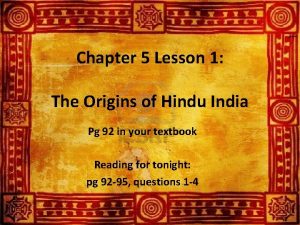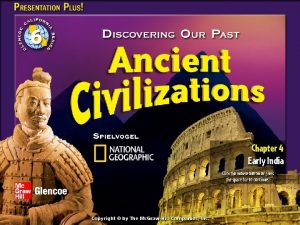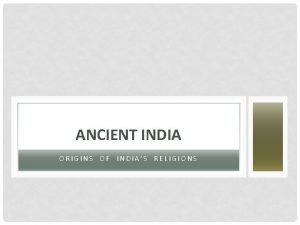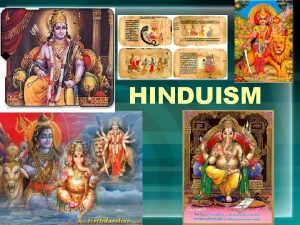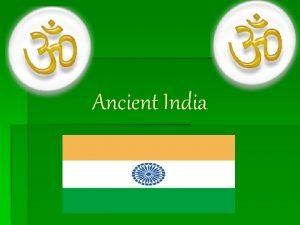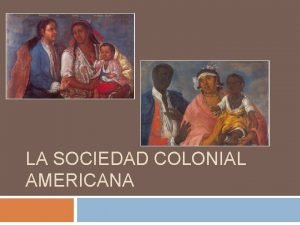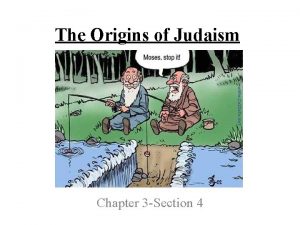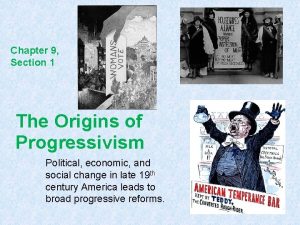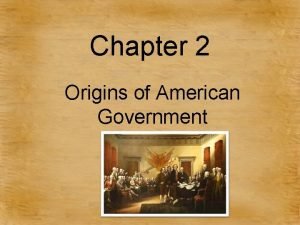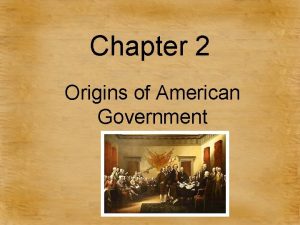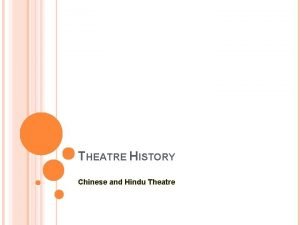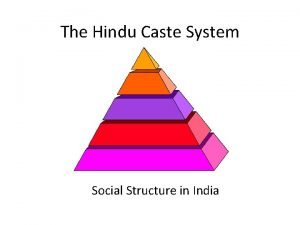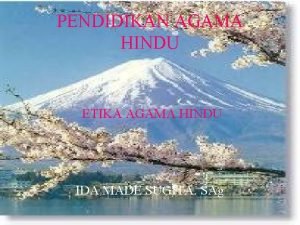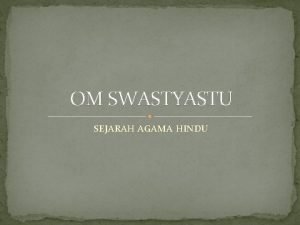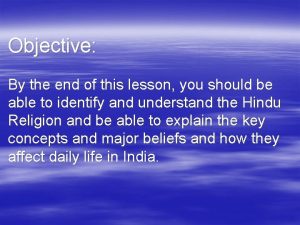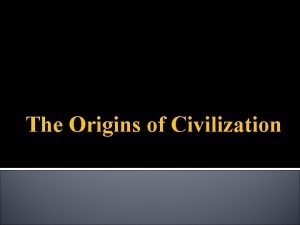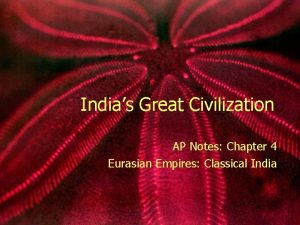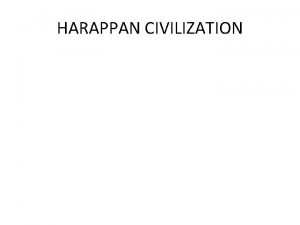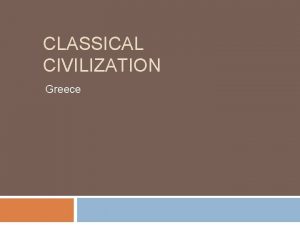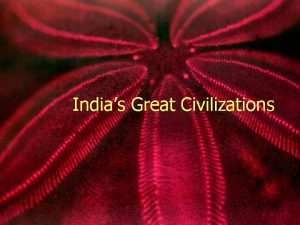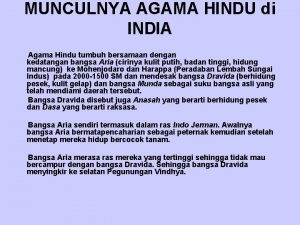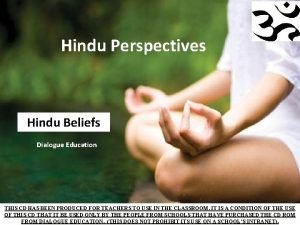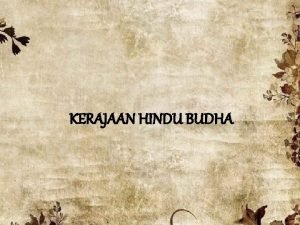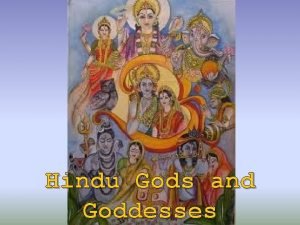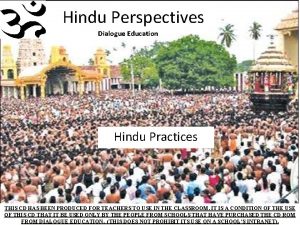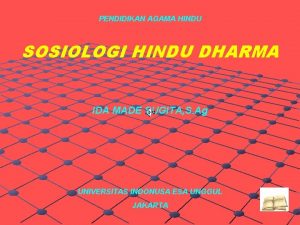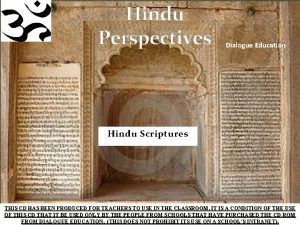Indias Great Civilization Chapter 3 Origins of Hindu





























- Slides: 29

India’s Great Civilization Chapter 3

Origins of Hindu India Section 1

Origins of Hindu India The Aryans were an Indo-European group of tall, light-skinned warriors who settled the areas north of the Black and Caspian Seas around 1500 B. C. The Aryans were organized loosely into tribes of nomadic herders who subdued the inhabitants of the Ganges Plain and developed a civilization that eventually spread over South Asia.

Aryan Language and Traditions They had no written language, their spoken language, Sanskrit, became one of the major languages of India. Sanskrit is an Indo-European language with many of the same root words as English, Spanish, French and German. Hymns and epic poems were handed down generation to generation by word of mouth. After the development of a written form of Sanskrit, the hymns and poems were collected into a holy book, the Vedas, which became the basis of Aryan religious practices.

The Vedic Age The Aryans left no artifacts or structures. All that we know of them comes from the Vedas. Indian history from 1200 B. C. to 500 B. C. is known as the Vedic Age. The oldest of the Vedas, the Rig-Veda dates from around 1000 B. C. and is one of the oldest religious texts still in use. It is also valuable to historians because it provides a description of early Aryan life.

Caste System (Varnas) • Castes determined by the Brahmans: priests Kshatriyas: warriors, rulers Viasyas: common people, merchants, artisans, farmers Sudras: unskilled laborers, servants Pariahs: untouchables, slaves previous life • caste system is a rigid social system that allows for NO social change • Occupation, marriage, education, even diet is determined by hereditary caste • Promoted social harmony – everyone followed rules of behavior • Pariahs are not part of the system and are called untouchables b/c they are considered dirty

Concept of Duty The Vedas outlined the dharma, or duties, of the males that belonged to each varna. Members of each varna were urged to do their duty including doing what was age appropriate. Men were expected to follow an occupation, choose a wife, and raise a family appropriate to his class. As he neared death, he withdrew from his friends and family to pray. A woman was educated in household tasks, married and served her husband family until he died or retired. At this time, she was expected to retire from active life and be taken care of by her sons and their wives.

Two Great Epics Two great epics addressed the concepts of good and evil and became the basis for India’s two great religions. The Mahabharata is composed of 1, 000 verses and is long as the first five books of the Bible. Woven among the verses is the story of two families’ struggle for power and discussions on religion and philosophy. The second epic, the Ramayana, is 24, 000 verses that tell the story of Rama and the ideal king, and Sita his faithful wife.

Hinduism Over time, the Aryan religion evolved into Hinduism, which became the national religion of India. Hinduism was not founded on the teachings of one person or holy book. It is based on different beliefs and practices, many of which are found in the Vedas and the Indian epics. As a result, Hinduism became a complex religion of many deities. A religious text, the Upanishads was written between 800 and 400 B. C. in an attempt to explain many of the aspects of the religion.

Basic Hindu Beliefs Three important gods emerged – Brahma (the Creator), Vishnu (the Preserver) and Shiva (the Destroyer). There is one universal spirit called Brahman Nerguna which is reflected as the souls of gods, humans and animals. They are tied to the material world for a short time through their bodies. Ultimately, these souls are released from the material world and united with the Universal spirit, Brahman Nerguna.

Basic Hindu Beliefs Forms of self-denial such as fasting and the practice of yoga to achieve tranquility were taught to help people achieve union with the universal spirit. Reincarnation is the belief that the soul passes through many lifetimes before it achieves union with the universal spirit. Karma is how well one fulfilled his dharma, which then determines what form the person will take in the next life. Ahimsa is the principle of nonviolence toward all living things. Moksha is the ultimate aim of life and describes the state of the person being released from the pain and suffering of rebirth. The soul achieves oneness with Brahman Nerguna.

Jainism Through time, many people stressed different aspects of the Hinduism. Mahavira, who was born a wealthy noble, traveled the country emphasizing the principle of ahimsa. Around 500 B. C. his teachings involved into the religion of Jainism that rejected sacrifices and the rigid social divisions. His followers, called Jains, used brooms to sweep aside insects underfoot and refused to farm for fear of plowing under living things. They turned to commerce and gained great wealth and influence.

Rise of Buddhism

India’s Second Great Religion During the 500 B. C. ’s dissatisfaction arose over the external rituals of Hinduism. As a result, many new religions developed during this time. The most influential of these new religions was Buddhism, founded by a Kshatriya prince named Siddhartha Gautama.

Siddhartha Gautama was born into a life of luxury around 566 B. C. At the age of 29, he was exposed to the harshness of life when he saw examples of sickness, old age and death. This distressed him so much that he left his wife and newborn son to wander around India in an attempt to discover why people suffered. He lived as a hermit for seven years and sought the truth through fasting and self-denial, but did not gain insight until he was sitting under a tree meditating. He donned a yellow robe and began to attract followers as he taught about his “enlightenment. ” His closest friends began to call him the Buddha or “Enlightened One. ”

Basic Beliefs of Buddhism 1) 2) 3) 4) Four Noble Truths All people suffer and know sorrow. People suffer because their desires bind them to the cycle of rebirth. People could eliminate suffering by eliminating their desires. Desires could be eliminated by following the Eightfold Path. 1) 2) 3) 4) 5) 6) 7) 8) Eightfold Path Know the truth Resist evil Say nothing to hurt others Respect life Work for the good of others Free the mind of evil Control thoughts Practice meditation

The Legacy of Buddhism After the Buddha’s death, his followers carried his religion to other parts of Asia, especially China, Japan and Korea and the Middle East. Buddhism also led to the flowering of architecture and the arts. Stupas, or large stone mounds, were built over the bones of Buddhist holy people. These stupas were decorated by elaborate art and statues of the Buddha. Books abut the Buddha’s life were often beautifully decorated.

Divisions of Buddhism Theravada Mahayana • Established in South Asia and Southeast Asia • Became dominant in China, Korea and Japan • Remained fairly close to the teachings of the Buddha • • Buddha is regarded as a teacher Encourages the worship of the Buddha as a divine being and savior

India Today, only a few Indians are Buddhists. Most are: • Hindus • Muslims • Jains • Christian Buddhism has gained new followers in India and the West.

Indian Empires Section 3 Pages 211 -214

The Mauryan Empire Even though India has high mountain barriers in the north, it has never been completely cut off from other lands. Mountain passes allowed invaders to reach the Indus River Valley. The Persian ruler, Darius I conquered the area in 500’s B. C. It was taken by Alexander the Great in 327 B. C. Indian traders had a thriving trade with the Roman Empire. During this time, no Indian king or foreign conqueror had success in uniting the separate kingdoms into one Indian nation. During the invasion of Darius the ruler of Magadha was King Bimbisara who expanded the kingdom north through conquest and marriage. It will become the center of India’s first empire.

Chandragupta Maurya In 321 B. C. , a military officer named Chandragupta Maurya overthrew the Magadhan king and proclaimed himself ruler. He was a skilled administrator whose achievements included the development of an efficient postal system. Control of the empire was achieved through the use of a strong army and extensive spy network. This kingdom included most of northern and central India and lasted until 184 B. C.

Asoka Grandson of Chandragupta whose rule began in 274 B. C. with fierce wars of conquest Indian civilization blossomed under his reign and covered two-thirds of the Indian subcontinent. After a particularly violent battle, Asoka was horrified at what he saw and renounced war and vowed to never rule by force or terror again. He kept his word, became a follower of the teachings of Buddha and was known as a man of peace.

Contributions of Asoka To make sure that laws protecting the welfare of others were widely known, he had them written in local languages. The laws were known as the Rock Edicts because they were carved on rocks and tall stone pillars throughout the vast empire. Asoka provided free hospitals and veterinary clinics. He built fine roads, with rest houses and shade trees for the comfort of travelers. He promoted Buddhism, but allowed the practice of Hinduism to continue

Collapse of the Mauryan Empire After the death of Asoka in 232 B. C. the empire declined because his successors were not as enlightened. They levied heavy taxes on the goods sold by merchants, and seized large portions of the crops grown by peasants. This caused the people to turn against the Mauryan rulers. After the last Mauryan ruler was murdered in 184 B. C. , northern India again split into many small warring kingdoms.

The Gupta Empire After the Mauryan Empire, 500 years passed before much of India was united again. About A. D. 310, Chandragupta I began to build an empire, using Magadha as his base. He was not related to Chadragupta Maurya, but did establish the Gupta dynasty which ruled Northern India for more than 200 years. This Gupta period would become known as India’s Golden Age because the arts and sciences flourished. The Guptas ruled a smaller territory than the Mauryas. They never gained control over the Indus Valley or the Deccan plateau which covers most of India’s southern peninsula.

Gupta Society 1) 2) 3) 4) 5) The Gupta’s managed to build a strong state and worked to maintain unquestioned authority. Some of the methods that they used were: Trained soldiers Used spies and political assassins Encouraged learning based on the ideas found in the Upanishads Made Hinduism the religion of their empire Built elaborate Hindu temples

Gupta Science Gupta mathematics contributed to modern mathematics in the development of some of the principles of algebra Explained the concept of infinity and invented the concept of zero The symbols they developed for the numbers 1 to 9 and are known as Arabic numerals Astronomers knew that the earth was round and had some knowledge of gravity They set bones, performed surgery and invented hundreds of medical instruments

The Golden Age Ends The empire began to fail in A. D. 415 qfter the death of Chandragupta II. They were the target of invaders as their government weakened. By A. D. 600, the Gupta Empire had dissolved into a collection of small states. Much of the culture that was uniquely Indian survived.
 Lesson 1 origins of hindu india answers
Lesson 1 origins of hindu india answers Indias first civilization
Indias first civilization Indias religions
Indias religions Indias religions
Indias religions Indias major religion
Indias major religion Indias first empire
Indias first empire Flota de indias ruta
Flota de indias ruta Sistemang caste
Sistemang caste Virreinatos capitanias y audiencias
Virreinatos capitanias y audiencias Indias first empire
Indias first empire Chapter 15 origins of biological diversity answers
Chapter 15 origins of biological diversity answers Chapter 3 section 4 the origins of judaism answer key
Chapter 3 section 4 the origins of judaism answer key Chapter 18 section 1 origins of the cold war
Chapter 18 section 1 origins of the cold war Origins of the cold war chapter 18 section 1
Origins of the cold war chapter 18 section 1 Origins of american government vocabulary
Origins of american government vocabulary The origins of progressivism chapter 9 section 1
The origins of progressivism chapter 9 section 1 Chapter 2 origins of american government answer key
Chapter 2 origins of american government answer key Chapter 2 origins of american government worksheet answers
Chapter 2 origins of american government worksheet answers Chapter 26 section 1 origins of the cold war
Chapter 26 section 1 origins of the cold war Chapter 2 lesson 1 origins of american government
Chapter 2 lesson 1 origins of american government Chapter 2 origins of american government
Chapter 2 origins of american government 876 roman numerals
876 roman numerals Hindu theatre
Hindu theatre World of
World of India most powerful caste
India most powerful caste Sandaran adalah
Sandaran adalah Etika agama hindu
Etika agama hindu Fase perkembangan agama hindu di india
Fase perkembangan agama hindu di india Hindu reincarnation chart
Hindu reincarnation chart Literatura antigua origen
Literatura antigua origen
